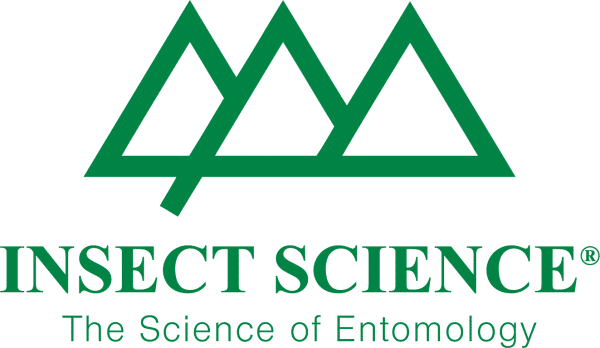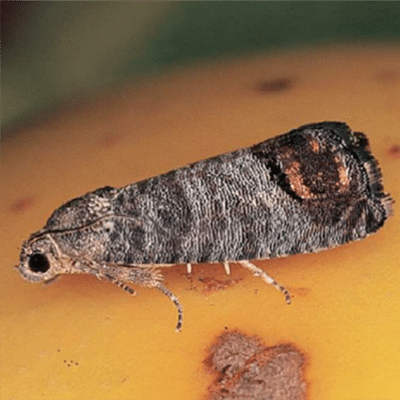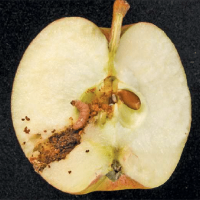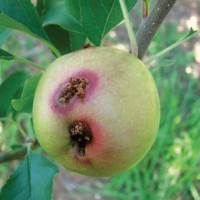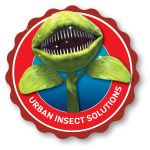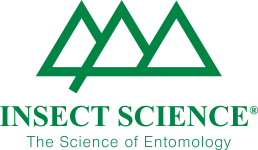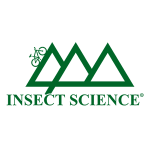Host plants
The preferred host plants are pome fruits, especially apple, pear and quince. Other less important cultivated host plants are crab apple, apricot, peach, plum, prune, cherry, and walnut. Infestation of these fruits often takes place when in close proximity to primary host plants.
Damage
Although young larvae may feed on leaf tissue and have been reported to bore into twigs, they are primarily internal fruit feeders. Damage is classified as stings (shallow entries where the larva damages the surface of the fruit before dying or trying another point of entry) or deep entries (when the larva tunnels into the core of the fruit and feeds on the seeds, as illustrated). Although shallow entries early in the season can result in severely malformed fruit, when caused later in the season they result in the fruit merely forming a shallow callous at the entry point. However, both types of damage render the fruit unmarketable.
Fruit infestation can take place from fruit set right through to harvest. During early fruit development in spring, up to 80% of first instar larvae enter fruit through the calyx. Only toward the end of November do an increasing number of larvae enter through the sides of the fruit. Generally the first instar larva stays and feeds just under the epidermis until reaching the second instar, when it bores through the flesh of the fruit to the core, also feeding on seeds. During feeding the larva excretes granular brown frass, some of which is pushed out of the tunnel entrance (illustrated).
Codling moth is a key pest of apples and pears worldwide. Since it was first reported in South Africa in 1885, codling moth has remained a major pest of apples and pears and, to a lesser extent, of apricots. If uncontrolled it has the potential to destroy the entire crop. It is an expensive cost for codling moth control – in 2011 the estimated cost for codling moth control in South African apple and pear orchards was R67 million.
Life history
Females each lay an average of 150 eggs, singly on the wood, leaves or fruit. Depending on the temperature, incubations lasts 6-16 days, and the larval period 21-28 days. Fully grown larvae overwinter in an inactive state referred to as diapause – a state of delayed biological development. Diapause allows the insect to synchronize its seasonal activity with the presence of developing fruits on its host trees, and is generally induced by shortening day-length and a fall in temperature during autumn. Mature larvae about to enter diapause leave the fruit and spin thick, silken cocoons in sheltered places – under loose bark, in crevices and pruning cuts on the tree, on support poles, on large pruning’s on the ground and even in bulk bins used during harvest.
Few larvae spin cocoons on the soil, and of those that do there is a high mortality. They spend the winter in this stat of larval dormancy, which is broken by an increase in temperature and photoperiod in spring. After completion of larval development and pupation, which lasts 14-21 days, the emergence of adult moths coincides with blossom and fruit set of the host plant.
The first spring moths begin to emerge in September, about a month prior to full bloom. Mating can take place on the same day that the adults emerge. Moths are most active prior to and just after sunset, when most of them mate. The adults live from 11-22 days. The total developmental time from egg to adult of non-diapause individuals is from 40-65 days.
There are three larval generations per year in South Africa, though a partial fourth generation can occur. In successive generations, progressively more larvae enter diapause until the third generation (or fourth if there is one), when all larvae enter diapause.
Natural enemies
The following indigenous South African parasitoids are known: two larval parasitoids, Pimpla ablbipalpis Cameron (also attacks pupae) and Erin pomonellae (Cameron), which belong to the Icheneumondiae, and the trichogrammatid egg parasitoid Trichogrammatoidea lutea Girault. Several ichneumonid and braconid parasitoids were introduced into the Western Cape from France, Italy, USA and Canada in earlier years for the biological control of codling moth. Of these, only the braconid egg-larval parasitoid, Ascogaster quadridentate Wesmael became established.
Larval predators recorded from South Africa include the cricket Gryllus bimaculatus De Geer (Gryllidae), the bugs Coranus papillosus (Thunberg), Pirates sp. (Reduviidae) and Diploxys hastata (Fabricuis) (Pentatomidae), the carabid beetle Chlaenius dichrous Weidemann, and the ants Dorylus helvolus (Linneaus) and Linepithema humile (Mayr).
The use of entomopathogenic nematodes in integrated pest management is increasing, and commercial nematode products are available overseas. In South Africa it has been found that Heterorhabditis zealandica Pionar (Heterorhabditidae) is the most promising species against codling moth.
Management
Codling moth is a key pest of pome fruit with a low economic threshold, and as such requires an effective monitoring system that provides accurate information on the seasonal occurrence and development of the pest. Adult populations should be monitored weekly during the growing season with sex pheromone traps to provide information on the start, peak, and end of the moth flights, the relative size of populations, and to monitor the effectiveness of control. The efficacy of pheromone traps in timing treatments is enhanced with the use of the codling moth degree-day phenology model, which permits chronological events in codling moth development, such as first egg hatch or commencement of adult flights, to be pin-pointed.
The exclusive use of insecticides for control is not sustainable due to the development of codling moth resistance to the insecticides. Pheromone-based mating disruption has been developed as an excellent and ecologically-compatible means of controlling codling moth in commercial orchards. Dispensers containing components of the female sex pheromone are attached to trees at densities of 300-1000 per ha, depending on the product being used and the population level. Mating disruption in combination with selected insecticides has led to a significant reduction in insecticide use for codling moth control. Where circumstances dictate the use of insecticides only, an insecticide resistance management strategy should be followed. This usually involves treating each larval generation with an insecticide from a different chemical group.
Other pheromone-based control methods for codling moth involve the use of “attract and kill” bait stations, and mass trapping using a very high density of pheromone traps.
The above-mentioned natural enemies generally do not keep codling moth in commercial orchards below economic levels. Entomopathogenic nematodes can be particularly useful in the treatment of bulk bins before fruit is placed in cold storage, and before empty bins are placed in orchards for harvest. The sterile insect technique is also currently being evaluated in South Africa for codling moth control. Management of codling moth can be improved further by following sound horticultural practices, such as correct pruning and fruit thinning, clean-picking harvest, and post-harvest sanitation.
